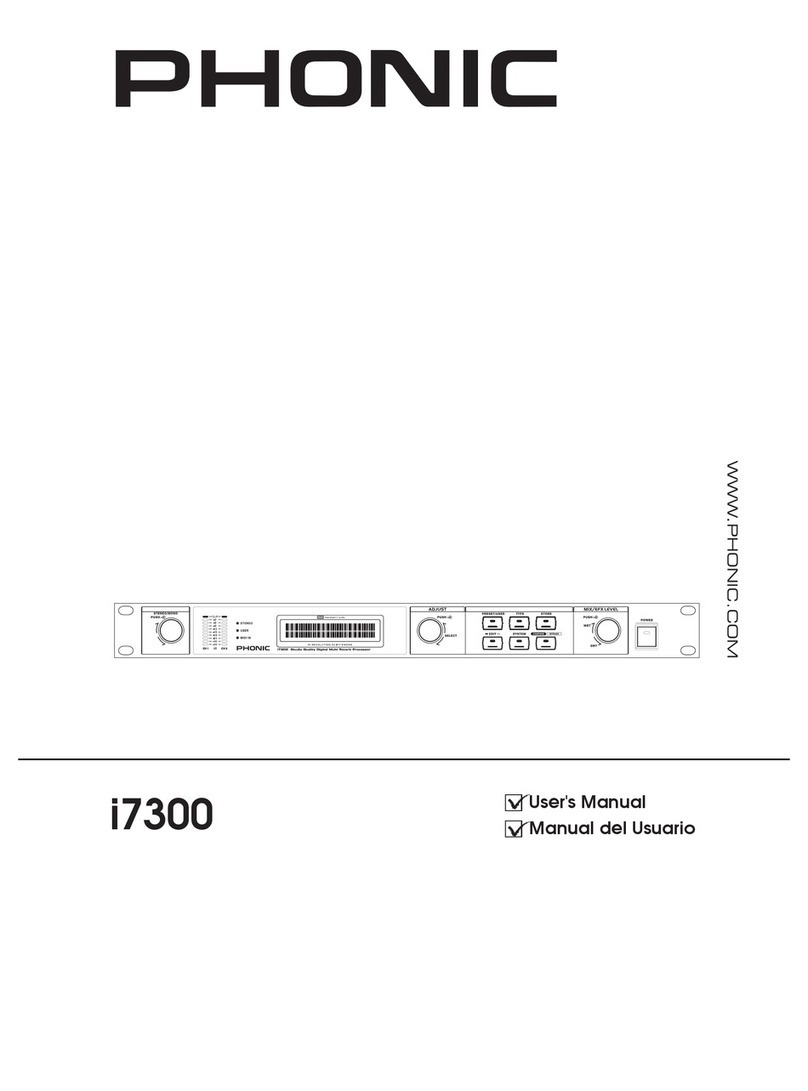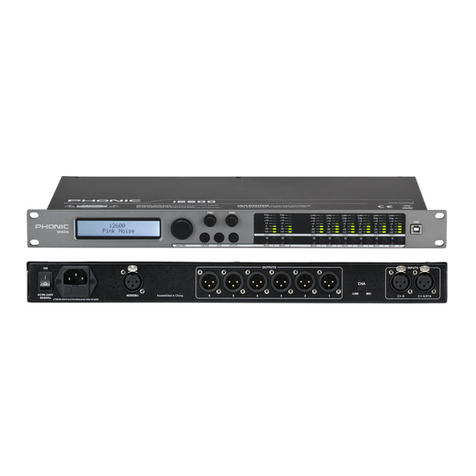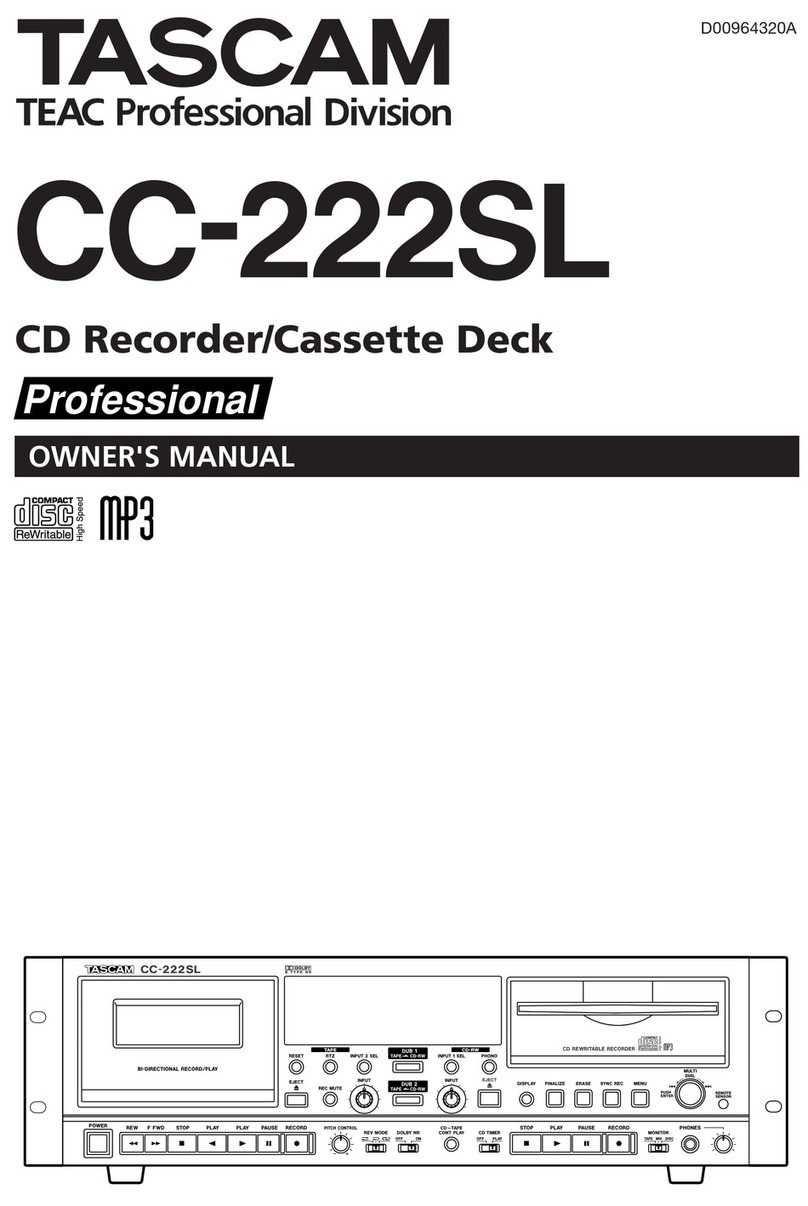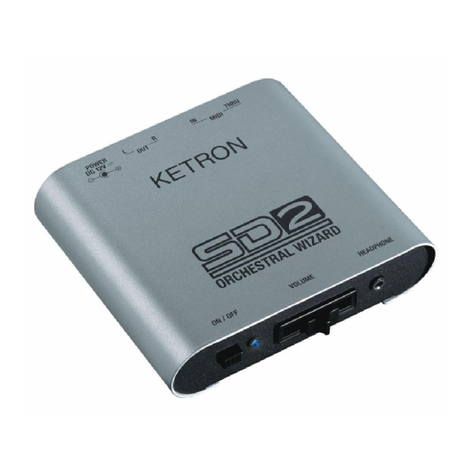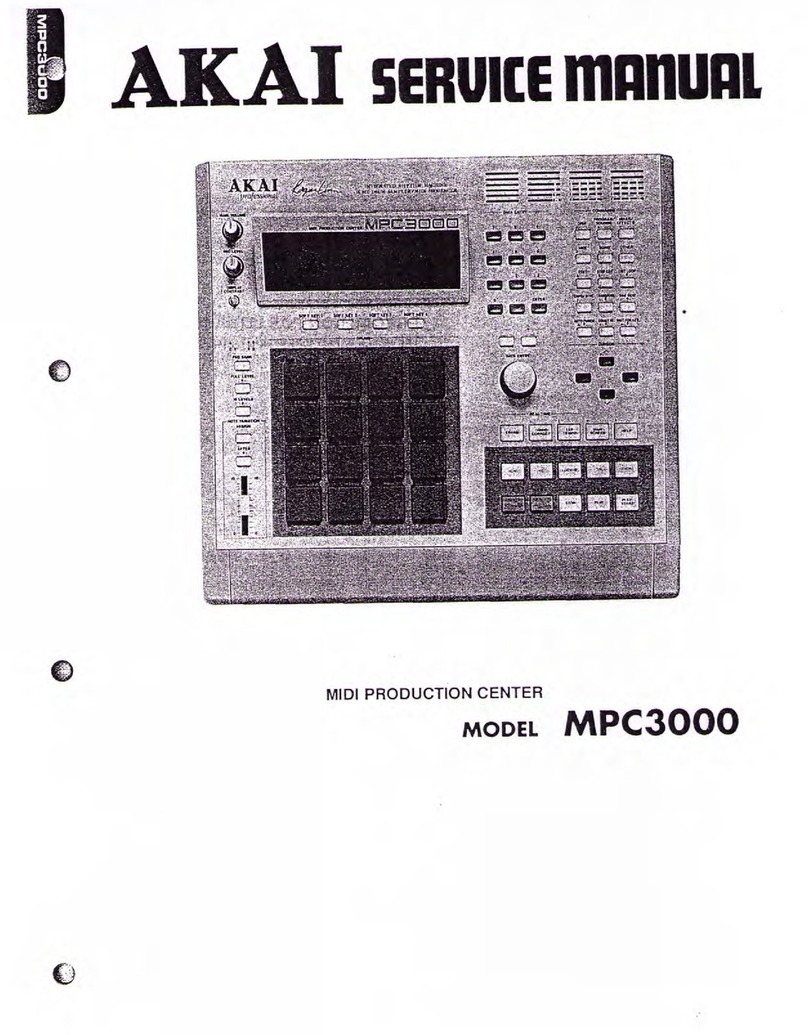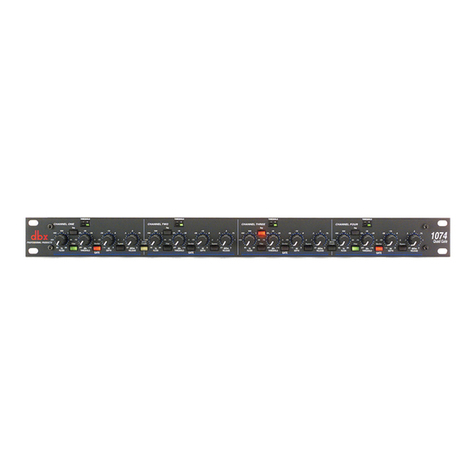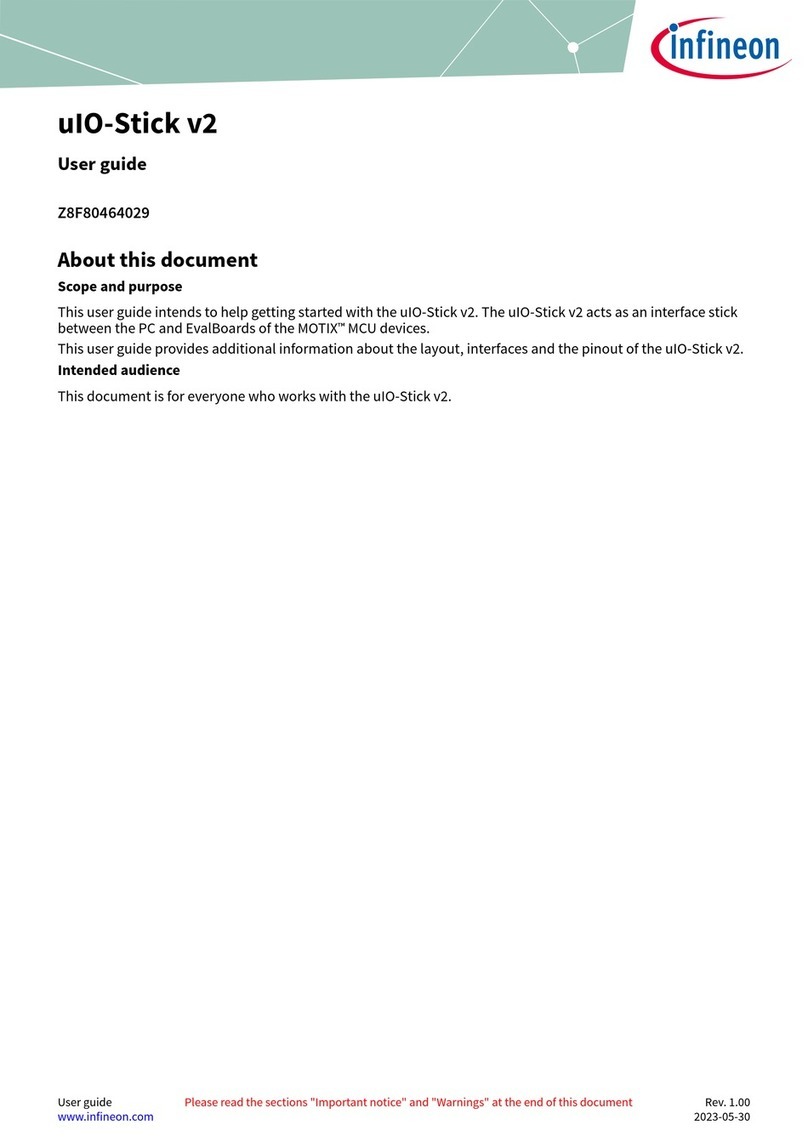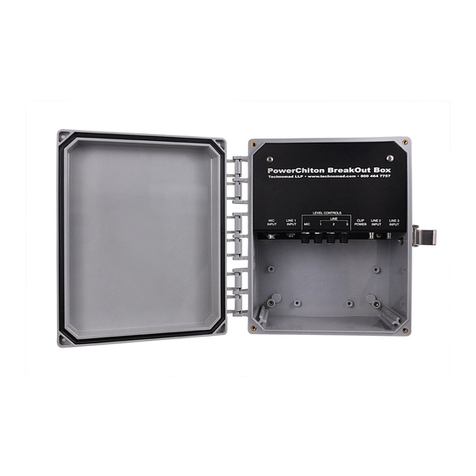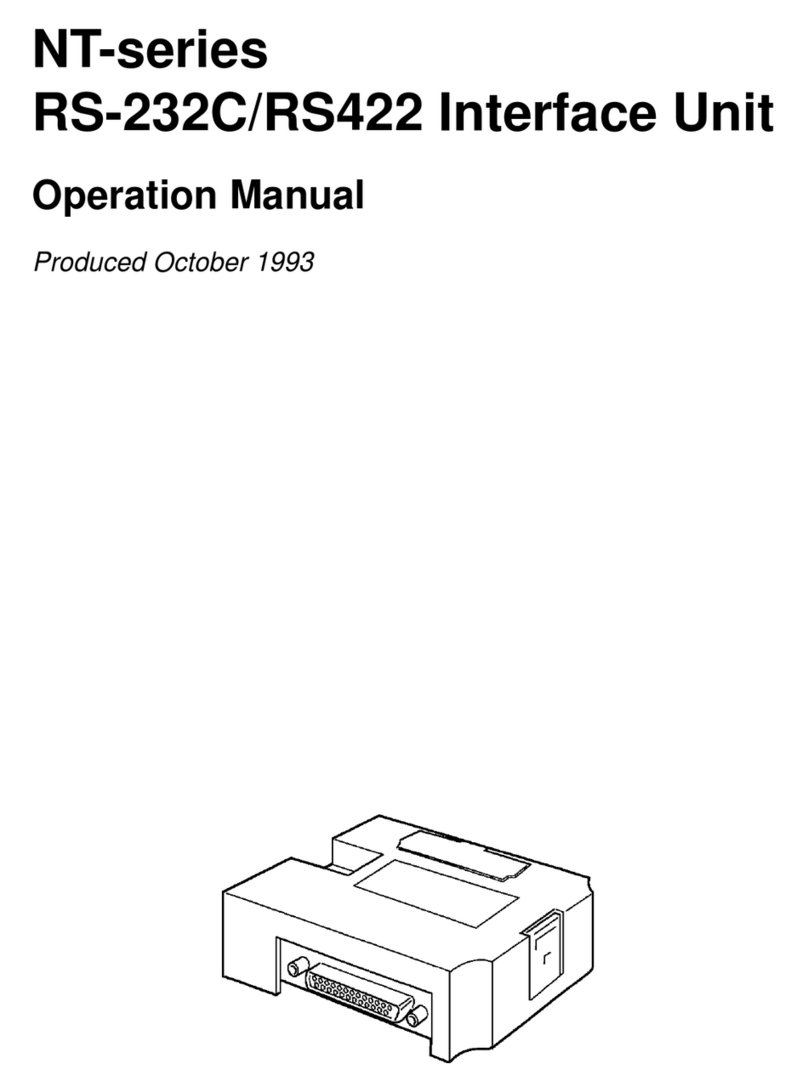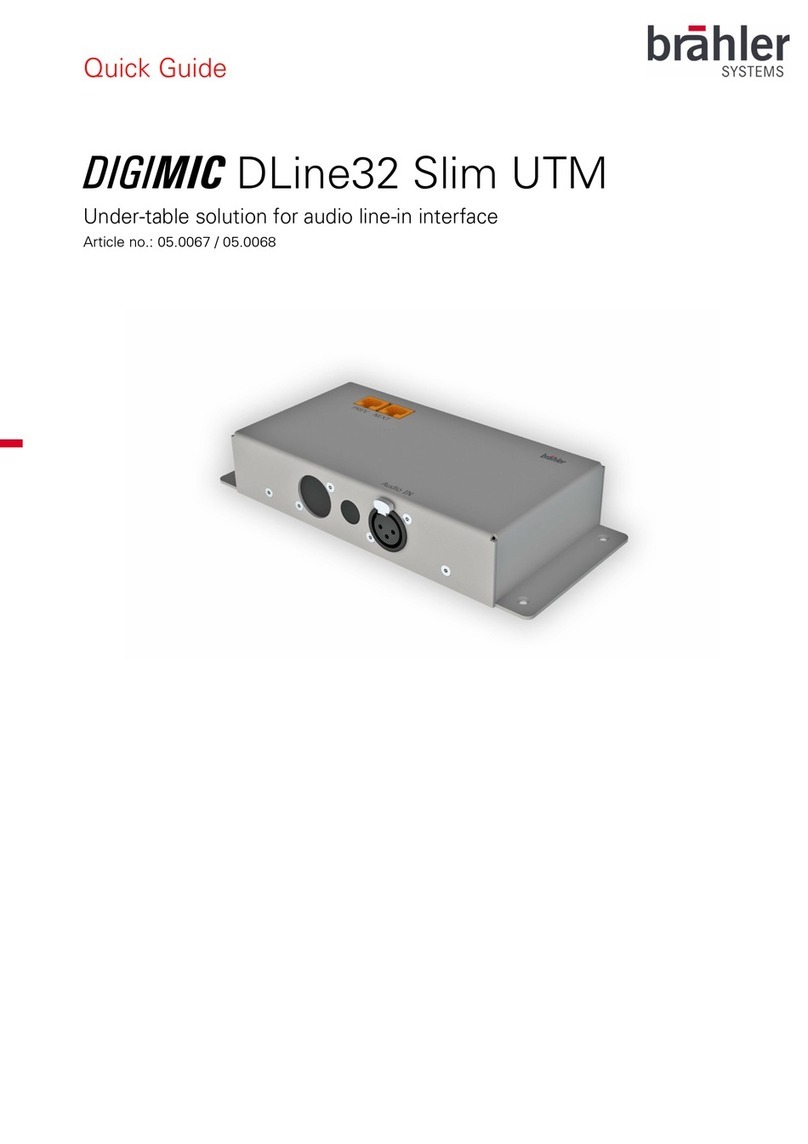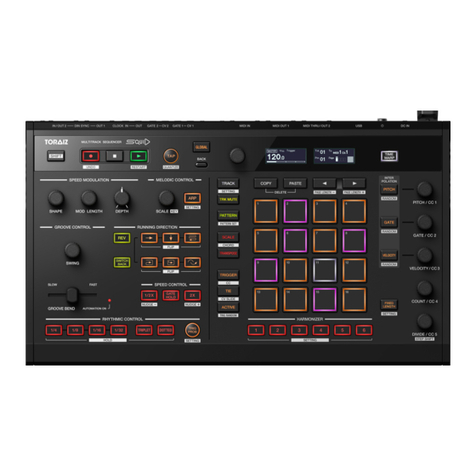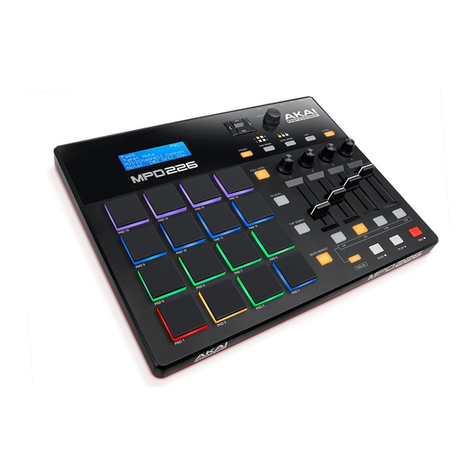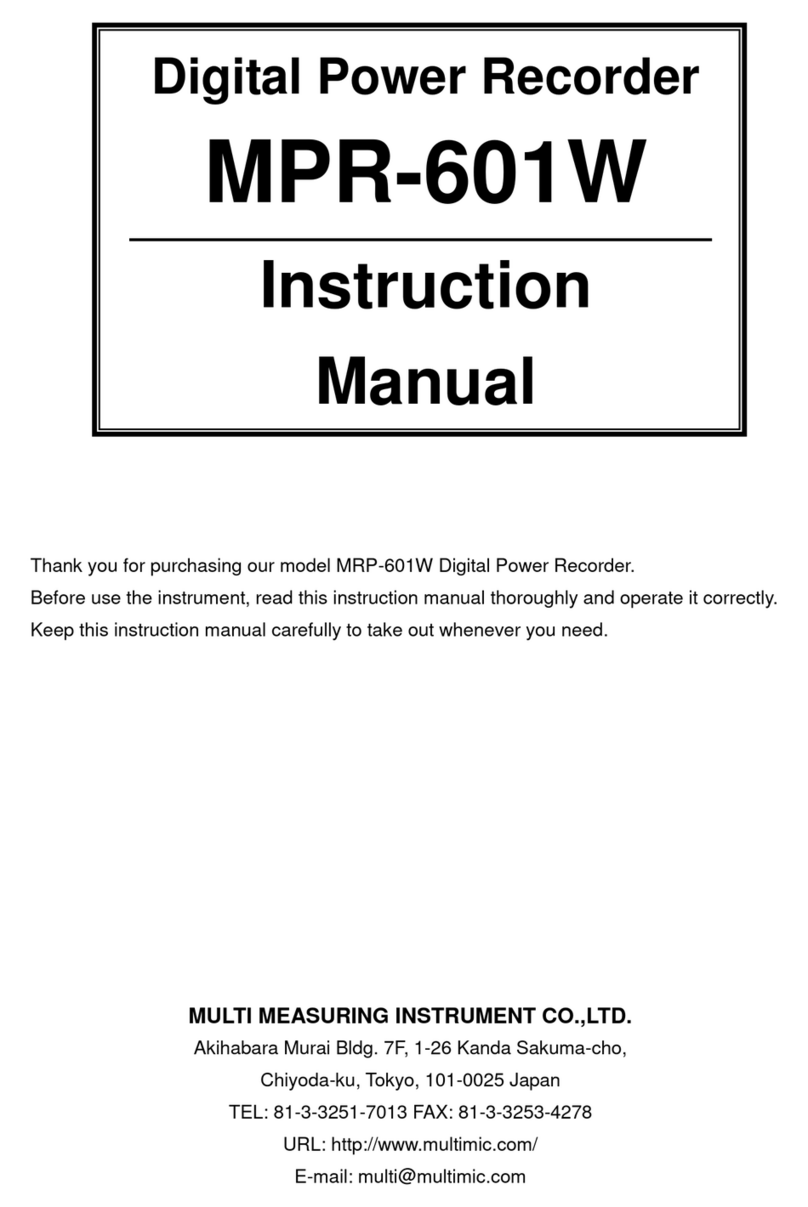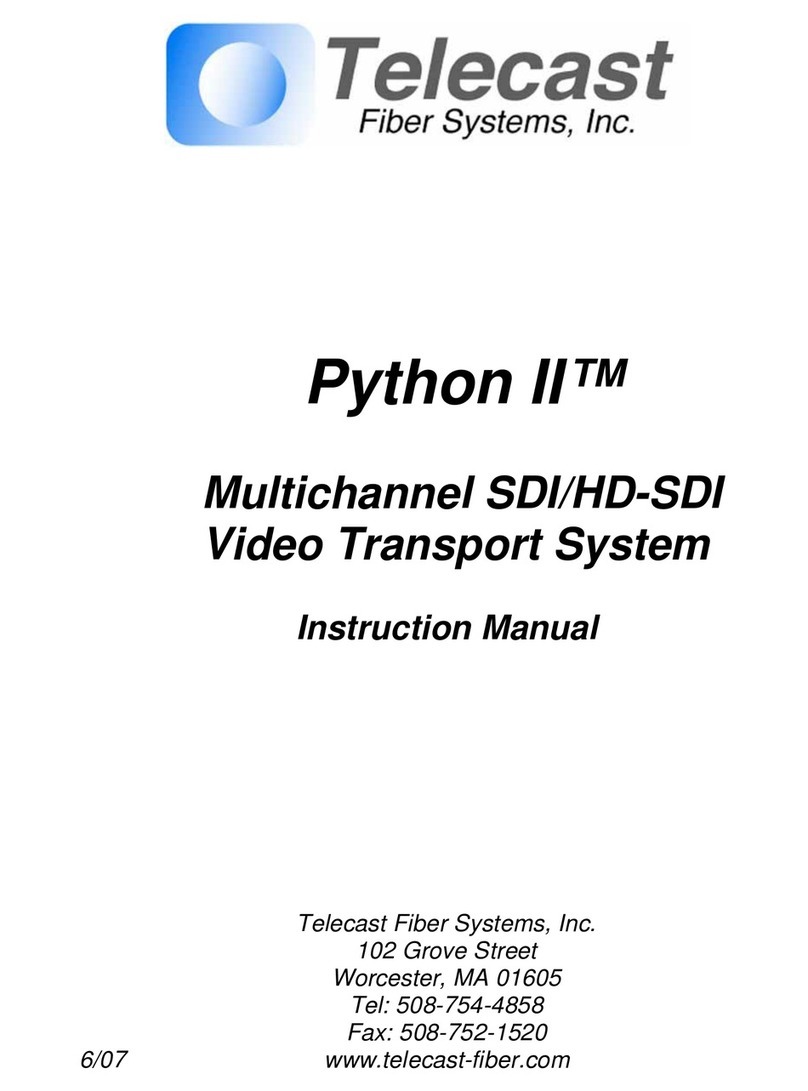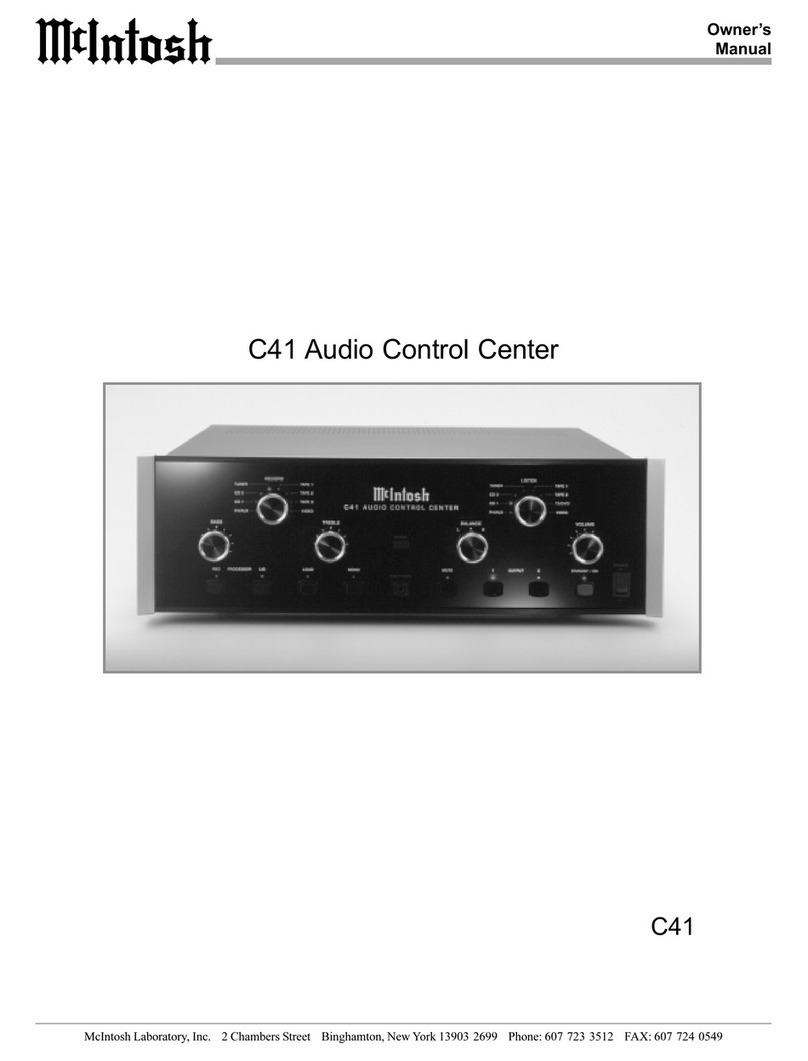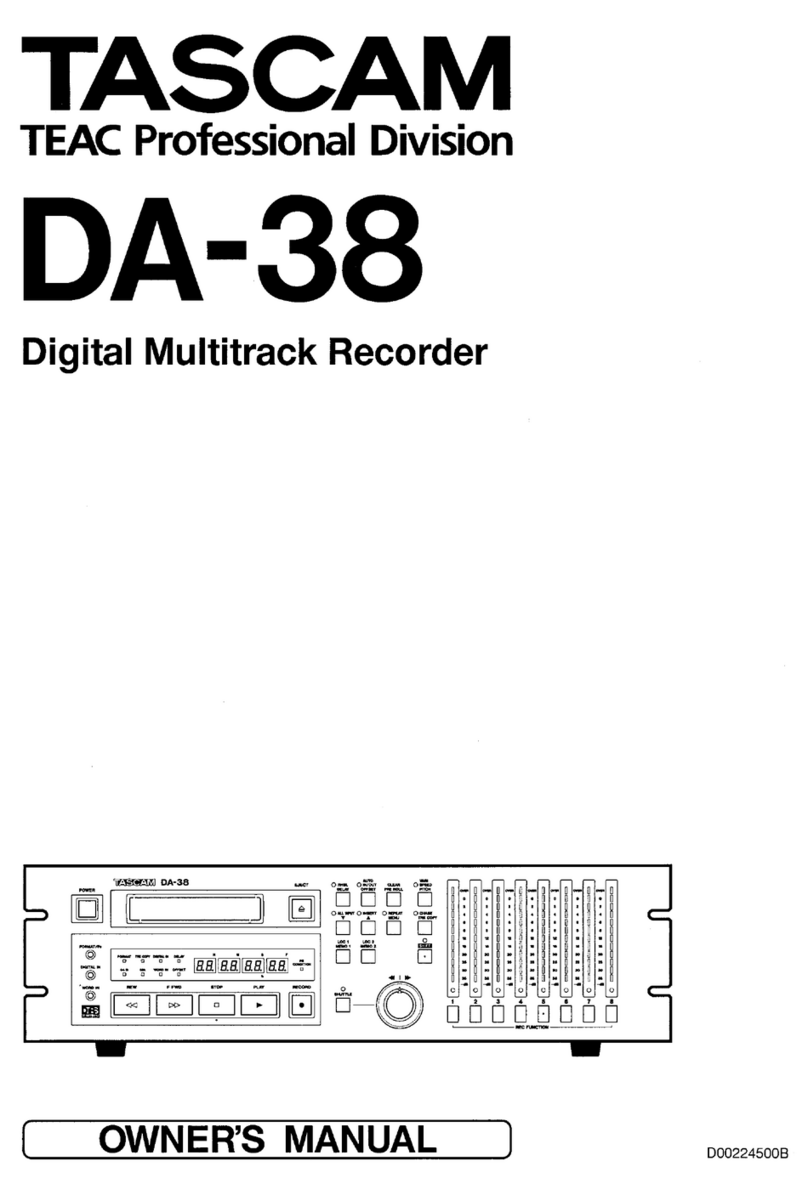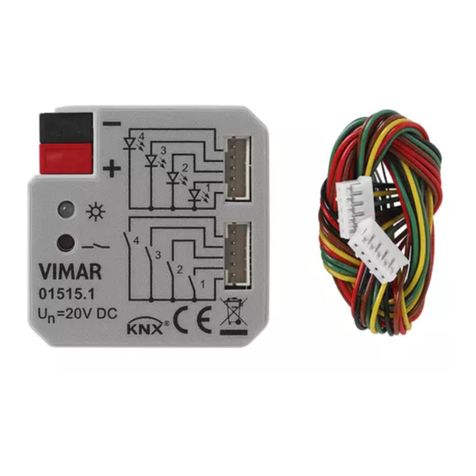Phonic FIREFLY 302 USB User manual

FIREFLY 302 USB User's Manual
Manual del Usuario

English Español
PORTABLE USB AUDIO INTERFACE
INTERFASE DE AUDIO USB PORTABLE
ENGLISH .....................................I
ESPAÑOL .....................................II
V1.1 06/15/2012
FIREFLY 302 USB

Firey 302 USB
English
3
INTRODUCTION1
FEATURES1
INSTALLATION2
QUICK START2
FRONT PANEL DESCRIPTION3
REAR PANEL DESCRIPTION4
USB 2.0 INTERFACE5
DRIVER INSTALLATION5
CHANNELASSIGNMENT11
OPERATING WITH DAW SOFTWARE11
PC OPERATION12
MAC OPERATION14
SPECIFICATIONS17
APPENDIX
APPLICATION1
DIMENSION3
BLOCK DIAGRAM4
CONTENTS
USER'S MANUAL
Phonic preserves the right to improve or alter any information within this
document without prior notice

Firey 302 USB
4
English
1. Read these instructions before operating this
apparatus.
2. Keep these instructions for future reference.
3. Heed all warnings to ensure safe operation.
4. Follow all instructions provided in this document.
5. Do not use this apparatus near water or in locations
where condensation may occur.
6. Clean only with dry cloth. Do not use aerosol or liquid
cleaners. Unplug this apparatus before cleaning.
7. Do not block any of the ventilation openings. Install
in accordance with the manufacturer
’
s instructions.
8. Do not install near any heatsources such as radiators,
heat registers, stoves, or other apparatus (including
.
9. Do not defeat the safety purpose of the polarized or
grounding-type plug. Apolarized plug has two blades
with one wider than the other. A grounding type plug
has two blades and a third grounding prong. The wide
blade or the third prong is provided for your safety. If
the provided plug does not into your outlet, consult
an electrician for replacement of the obsolete outlet.
10. Protect the power cord from being walked on or
pinched particularly at plug, convenience receptacles,
and the point where they exit from the apparatus.
11. Only use attachments/accessories by the
manufacturer.
12. Use only with a cart, stand, tripod, bracket, or
table by the manufacturer, or sold with
the apparatus. When a cart is used, use caution
when moving the cart/apparatus
combination to avoid injury from tip-
over.
13. Unplug this apparatus during lighting
storms or when unused for long
periods of time.
14. Refer all servicing to service personnel.
Servicing is required when the apparatus has been
damaged in any way, such as power-supply cord or
plug is damaged, liquid has been spilled or objects
have fallen into the apparatus, the apparatus has
been exposed to rain or moisture, does not operate
normally, or has been dropped.
IMPORTANT SAFETY INSTRUCTIONS
CAUTION: TO REDUCE THE RISK OF ELECTRIC SHOCK,
DO NOT REMOVE COVER (OR BACK)
NO USER SERVICEABLE PARTS INSIDE
REFER SERVICING TO QUALIFIED PERSONNEL
The lightning flash with arrowhead symbol, within an
equilateral triangle, is intended to alert the user to the
presence of uninsulated
“
dangerous voltage
”
within the
product
’
magnitude to constitute a risk of electric shock to persons.
The exclamation point within an equilateral triangle is in-
tended to alerttheuser to thepresenceof important operat-
ingand maintenance(servicing)instructionsinthe literature
accompanying the appliance.
WARNING: To reduce the risk of or electric shock, do
not expose this apparatus to rain or moisture.
CAUTION: Use of controls or adjustments or performance
of procedures other than those may result in
hazardous radiation exposure.
The apparatus shall not be exposed to dripping or splashing and that no objects with liquids, such as vases,
shall be placed on the apparatus. The MAINS plug is used as the disconnect device, the disconnect device shall
remain readily operable.
Warning: the user shall not place this apparatus in the area during the operation so that the mains switch
can be easily accessible.
CAUTION
RISK OF ELECTRIC SHOCK
DO NOT OPEN

Firey 302 USB
English
1
INTRODUCTION
Congratulations on your purchase of one of the
newest members of the Phonic Firey series
of recording interfaces, the Firey 302 USB.
Through the Firey’s ultra low-noise microphone
input and two line inputs, together with the USB
2.0 interface, users are able to digitally transfer
theiraudiotoacomputerinhighresolutionaudio
that meets today’s modern production standards
(24-bit, with a sampling rate selectable up to
192 kHz). Never again will you have to worry
about loss of audio, as the Firey is the only
tool you need to transfer those analog record-
ings to digital.
Light, easy to use, and with no problematic con-
guration necessary, the Firey certainly shines
when it comes to simplicity and mobility.
We know how eager you are to get started
– wanting to get the product out of the box and
hook it all up is probably your number one prior-
ity right now – but before you do, we strongly
urge you to take a look through this manual.
Inside, you will nd important facts on the set
up, use and applications of your brand new
Firey. If you do happen to be one of the many
people who atly refuse to read user manu-
als, then we just urge you to at least glance at
the Instant Setup section. After glancing at or
reading through the manual (we applaud you if
you do read the entire manual), please store it
in a place that is easy for you to nd, because
chances are there’s something you missed the
rst time around.
FEATURES
● 5 x 6 24-bit/192kHz USB stream I/O
● 2 x 2 analog operation (RCA)
● Front-panel microphone in (XLR) with
+48V phantom power
● Headphone output with dedicated level
control
● Near-zero latency ASIO software direct
monitoring
● Power indicator LED
● DC power supply included
● Easy-to-see signal and clip LED indica-
tors for input and output
● Mac OSX and Windows XP / Vista
compatible

Firey 302 USB
2
English
INSTALLATION
1. Turn your computer on and connect the Fire-
y 302 USB to the computer via the included
USB cable. It is recommended not to turn
the unit’s power on just yet, however.
2. Run the setup.exe le on the included driver
CD, and follow the installation instructions
displayed on screen.
3. When prompted to “disconnect and recon-
nect” the Firey, change the power select
switch on the rear of the device to DC IN.
4. Continue to follow the on-screen installation
instructions to nalize the setup.
5. Open your audio editing / DAW software,
and check the Firey’s ASIO driver has been
read successfully by the program. This is
usually done in the “Devices” submenu. You
may also want to edit the Firey’s properties.
This is usually done by clicking on the Tools
pull down menu, and selecting “Properties”.
In this area, you can usually select the
Firey’s different inputs and outputs, and
assign them to various channels. This, of
course, depends on the software you are us-
ing, so check the software’s user’s manual
for more information.
QUICK START
1. ConnecttheDC convertertothe9-12V jack
in and change the power selector switch to
the DC IN position.
2. Plug your USB cable into Firey’s USB port
and the other end into any available USB
port on your computer. Provided you have
already installed the required driver, the
computer should detect your Firey 302
USB.
3. Connect a microphone to the XLR input
connector. Talk into the mic and check the
LED sig and clip indicators. Adjust the Mic
level control as you see necessary.
4. Connect any analog line inputs you wish to
use. We advise that you do not attempt to
use the 1/4” and RCA connectors on any
one input channel at the same time.
5. Open your audio software and congure it so
the Firey 302 USB is set as your input/out-
put device. Please note that the analog and
S/PDIFoutputscannotbeusedtooutputthe
signal from the computer simultaneously.
6. Plug your headphones into the headphone
output of the Firey to monitor the return
signal.
7. Now you are ready to design high resolution
audio productions.

Firey 302 USB
English
3
FRONTPANELDESCRIPTION
1. Power LED Indicator
When you connect the DC power converter and
change the power switch to the DC IN position,
the unit will be powered and the front power LED
will be illuminated.
2. Headphone Output Jack and Control
All the audio signals that are mixed on computer
can be monitored with the Headphone output. You
can also control the level of this signal with the
corresponding level control.
3. XLR Microphone Connector
This is a balanced microphone XLR 3-pin con-
nector, which you can use to connect dynamic or
condenser microphones. Phantom power may be
applied to allow condenser or ribbon microphones
to be connected.
4. Mic Gain
Turn this knob clockwise to increase the Micro-
phone input’s gain. You have 44dB of possible
gain with this knob, so please take care when
applying gain to ensure the Mic Clip LED does
not light up.
5. Gain 1 and 2
These knobs control the input gain for the RCA
and1/4”pluginputjackslocatedon therearpanel.
Turn them clockwise to increase the signal level
gain or turn them counterclockwise to lower the
input levels. Gain 1 controls the Analog In 1 RCA
and 1/4” TRS input jacks, and Gain 2 controls the
Analog In 2 RCA and 1/4” TRS input jacks. Each
gain control is independent of the other, so you
can easily match your input levels.
6. +48V Phantom Power
Pushing this button will activate +48V of phantom
power on the microphone input, allowing users to
connect condenser microphones, ribbon micro-
phones, or other input devices that require +48V
power to operate. If you are not entirely sure if
your mic requires phantom power, please refer
to the microphone’s operation manual or consult
the manufacturer.
7. Signal / Clip Indicators
These LED indicators give users an idea of when
theiranalogandmicinputsandoutputsarereceiv-
ing a signal (sig) and when that signal reaches high
peaks just prior to the signal being dynamically
clipped, which may cause undesirable effects to
the integrity of your audio (clip).
123
4
6 5 7

Firey 302 USB
4
English
REARPANELDESCRIPTION
8. Analog 1/4” TRS Inputs 1 and 2
These are balanced 1/4” TRS Line Inputs and can
be used to connect any line level devices, such as
CD players or DAT recorders.
9. Analog RCA Inputs 1 and 2
Theseare RCAinputs andcan beusedto connect
any device like CD players, DAT recorders, turn-
tables, and even analog mixers (taking the signal
from a mixer’s Record or 2 track outputs).
ImportantNote: Keep in mind that the two RCA inputs are
completely independent of one another; however these
inputs should not be used if the corresponding 1/4” analog
1 and 2 inputs are used, as doing so would have quite
undesirable results. You can, however, mix and match
these inputs. If, for example, you wanted to use Input 1’s
RCA connector and Input 2’s 1/4” connector that would
not cause any problems.
10. Analog 1/4” TRS Outputs 1 and 2
This are balanced 1/4” TRS Line Outputs with line
level signal (+4dBu). Use them to get a stereo
output channel and connect them to active moni-
tors (such as the Phonic P8A), or perhaps to an
amplier and a passive pair of speakers. You could
also use them with signal processors, mixers or
other external devices.
11. Analog RCA Outputs 1 and 2
These are RCA line outputs. They accept RCA
cables and can be connected to any external de-
vicethatuses RCAconnectors.Thiscould include
tape recorders and MP3 recorders.
12. S/PDIF In/Out
These are a standard S/PDIF Digital Audio In-
put/Outputs that can be use with digital mixers,
DAT recorders, or any external device that uses
this Digital format. The S/PDIF’s output sampling
rate is determined by the sampling rate set by
the Firey control software. Please use a 75 ohm
coaxial cable with RCA plug if you are using the
S/PDIFconnection,asthemostcommonproblems
associated with glitches in digital interfaces are the
result of using poor quality cables.
13. MIDI In/Out
You can have 16 simultaneous MIDI input/output
channels sent to and from your computer through
the Firey 302 USB.
14. USB Port
This is a digital USB 2.0 connector that you can
use to connect to your computer. Doing so allows
users to send their audio signal from the Firey to
the computer, and vise-versa.
15. 9-12VDC Input Power Jack
Connect the supplied DC converter to this jack to
feed the unit. Please only use this DC converter in
order to ensure no damage is done to the Firey. If
for any reason your converter gets lost or damaged
and you need a replacement, please contact your
local Phonic dealer.
16. Power Switch
Use this switch to turn the Firey 302 USB on
and off.
8910 11 12
13 14 15 16

Firey 302 USB
English
5
USB INTERFACE
SYSTEM REQUIREMENTS
The following are the minimum required specications for use with the Firey 302 USB. If your com-
puter does not meet these requirements, you will experience lagging of audio and possible freezing
of your computer when attempting to operate the Firey.
Windows
• Microsoft® Windows® XP (with SP2) or Microsoft® Windows® Vista
• Available USB 2.0 port
• Intel Pentium® 4 processor or equivalent AMD Athlon processor
• Motherboard with Intel or VIA chipset
• 5400 RPM or faster hard disk drive (7200 RPM or faster with 8 MB cache recommended)
• 256 MB or more of RAM (512 MB recommended)
Macintosh
• OS X Leopard 10.5.1 or later with USB support
• Intel Core 2 Duo or later processor (G4 processors are not supported)
• 256 MB or more of RAM (512 MB or more recommended)
DRIVER INSTALLATION
To use the Firey efciently (or at all) on any computer, it is important to install all the necessary
drivers from the included CD. We advise that users read all instructions carefully before continu-
ing on to each step of the installation process, as they will be asked to, however disconnect and
reconnect their Firey.
Windows XP (with Service Pack 1 or 2)
1. It is recommended that you quit all applications before starting the installation process.
2. Connect the Firey 302 USB to the computer, leaving the power of the unit off.
3. Insert the installation CD included with your Firey into the CD-ROM drive of your computer. If
the CD does not automatically start the installation process within a few moments, then navigate
to “My Computer” → your CD-ROM drive → “Firey302USB_Driver” → double-click “setup.exe”
to begin the installation manually. The Firey Control Panel software also will be installed at this
time.
4. Follow the on-screen installation instructions, turning the Firey on when asked to ‘disconnect
and reconnect’ the unit.

Firey 302 USB
6
English
Make sure no other programs are running on your PC and click “Next”.
Read and accept the terms of the License Agreement and click “Next” to continue.

Firey 302 USB
English
7
Either select a new destination for the installation,
or else click “Install” to accept the default directory.
The installation will then commence.

Firey 302 USB
8
English
Connect the Firey 302 USB to the computer and push ‘Finish’ to complete the installation.
If a message is displayed indicating that the software has not passed
Windows Logo test, click “Continue Anyway.”
After installation is complete, an installation complete message
will appear on screen. Click ‘Finish’ to exit.

Firey 302 USB
English
9
Mac OSX Driver Installation
1. It is recommended that you quit all applications before starting the installation process.
2. Do not connect the Firey 302 USB to the Mac until after you have installed the driver.
3. Insert the installation disc into the CD drive of your computer. If the CD does not automatically
start the installation process, navigate to your CD drive → “Phonic” → “Firey302USB” → then
run “PHONIC_FireyUSB.mpkg” to begin the installation manually. The Firey Control Panel
software also will be installed at this time.
4. Follow the on-screen installation instructions.
5. After installing the Mac driver, connect the Firey 302 USB to the Mac’s USB port.
Select “Change Install Location...” to select a new destination for the Mac software. If not, the
software will automatically be installed to the default location.

Firey 302 USB
10
English
Click ‘Close’ once the installation has completed.

Firey 302 USB
English
11
CHANNEL ASSIGNMENT
When using a Digital Audio Workstation on a PC,
and within the included Phonic Firey 302 USB
control panel software, the following names have
been attributed to the input channels of the Fire-
y.
If you would like to use the Firey 302 USB as
your default audio output device on your PC, sim-
ply go into the Windows control panel and select
“Sound andAudio Devices.” Select the Audio tab,
and use the pull-down menu to select one of the
Firey 302 USB’s inputs from the list of available
output devices. The Firey 302 USB can also be
selected as the default output device for individ-
ual programs by editing said programs’ settings
/ options.
OPERATING WITH DAW SOFT-
WARE
After successfully completing the installation pro-
cess, the following process must be followed to
work efciently with the Firey 302 USB. In the
following example, we are using Cubase - how-
ever most other software should be similar.
1. Open the program.
2. Go to the ‘Devices’ pull-down menu and select
‘Device Setup’. On the left, select ‘VST Multi-
track’.
3. From the ASIO Driver drop-down list select the
‘Firey302USB ASIO Driver’. A pop-up box will
ask you if you want to switch to the ASIO driver.
Click ‘Switch’. This completes the basic setup.
4. The following steps should be followed to activate
audio tracks received from or sent by the Firey
302 USB.
a. Go to the “devices” pull-down menu and se-
lect ‘VST Inputs’. This will display the various
inputs (“Analog In 1”, “Analog In 2”, etc.)
b. Activate channels by clicking the “Active” but-
ton located next to each channel name.
5. For further instructions on the operation of Cu-
base, please consult the owner’s manual by
pressing F1 while the program is open.
If you wish to reset the Firey ASIO driver, simply go
to the ‘devices’ pull-down menu and select ‘device
setup’. Simply click ‘reset’ and select the ‘Firey-
302USB ASIO Driver’. Click ‘ok’ to continue and the
Firey 302 USB should once again become func-
tional.
Channel Name Firey Channel
Analog In 1 1/4” and RCAAnalog Input 1
Analog In 2 1/4” and RCAAnalog Input 2
Mic In Microphone Input
Mic In Microphone Input
S/PDIF In S/PDIF Input
S/PDIF In S/PDIF Input
Midi In MIDI Input

Firey 302 USB
12
English
WINDOWS OPERATION
The Firey control panel on the PC can be ac-
cessed at any time by entering choosing the
shortcut from your Programs menu. This program
will not only allow users to alter their device and
channel names and properties, but will also let
them adjust buffer settings, change sampling
rates, and so forth.
Sample Rate
In this menu, users are able to adjust the sam-
pling rate of the Firey 302 USB. The sampling
rate can be chosen between 44.1, 48, 88.2, 96,
176.4 and 192 kHz. Press ‘apply’ once a new
sampling rate is selected.
Buffer Settings
The Buffer Settings menu is used to adjust the
Streaming Buffer, as well as the buffer settings
when using the ASIO and WDM drivers.
The ‘Streaming Buffer’ can be adjusted between
Minimum (1 millisecond), Small (2 milliseconds),
Large (4 milliseconds) and Maximum (8 millisec-
onds). The selection of the Streaming Buffer size
will determine the size of the ASIO and WDM buf-
fer sizes, as displayed in the table at the bottom
of this page.
When selecting a new buffer size, users can click
‘Apply’ to apply the newly selected buffer setting
to the device.
Streaming Buffer Setting
Minimum (1 ms) Small (2 ms) Large (4 ms) Maximum (8 ms)
Minimum 1.5 ms
66 samples 3.0 ms
132 samples 6.0 ms
256 samples 12.0 ms
529 samples
Small/Smaller 2.0 ms
88 samples 4.0 ms
176 samples 8.0 ms
353 samples 16.0 ms
706 samples
Large/Small 3.0 ms
132 samples 6.0 ms
256 samples 12.0 ms
529 samples 24.0 ms
1058 samples
Maximum/Standard 4.0 ms
176 samples 8.0 ms
353 samples 16.0 ms
706 samples 32.0 ms
529 samples
ASIO / WDM Buffer Setting

Firey 302 USB
English
13
Devices / Device0
In the Devices section, users are able to view and
edit the name of any Phonic USB Devices con-
nected to the computer. The Device0 menu of-
fers device info as well as a S/PDIF pass through
function for users to take advantage of. There is
also two driver-integrated mixers that users are
able to utilize to better customize their input/out-
put levels to suit their computer.
Hardware Inputs Mixer
This software-based mixer allows users to adjust
levels and routing options of all input signals of
the Firey 302 USB. All of the outputs from this
mixer can then be utilized by DAW and other suit-
able applications.
Level meters are incorporated into the mixing
software. Users are given visual depictions of
current incoming and outgoing signals from this
software mixer.
Software Inputs Mixer
This mixer allows users to monitor and adjust the
levels (and routing) of the output signals from
the PC. Like the Hardware Inputs Mixer, users
are able to adjust volume levels and mute out-
put tracks as necessary. Also like the Hardware
mixer, level meters are provided on the software
mixer’s inputs and outputs.
Input Channels
The Input Channels section allows users to view
and edit the name of the various input channels
received from the USB input. Please note that
the channel names used in the picture below may
differ from your unit’s.

Firey 302 USB
14
English
Output Channels
By entering the Output Channels section, users
can view and edit the names of the two analog
output channels and two S/PDIF output channels
that are sent from the computer to the Firey.
Driver Information
This section allows users to check the version
of their currently used driver and the interface.
New drivers will be made available from time to
time on the Phonic document center, and an an-
nouncement will usually be made on the Phonic
home page.
MAC OPERATION
After installing the Firey 302 USB driver and
software to your Mac computer, enter the Audio
MIDI Setup application and you should be able to
select the Phonic Firey 302 USB as your default
input and output device.
Also in the Audio MIDI Setup, you will be able to
adjust volume levels of your various input and
output signals, as well as the sampling rate and
resolution you want to use. Users are able to se-
lect between 44.1, 48, 88.2, 96, 176.4 and 192
kHz sampling rates. Resolution can be selected
between 24-bit, 20-bit and 16-bit. Both the sam-
pling rate and resolution can be adjusted in your
DAW software as well (depending on what soft-
ware you use).
Also in the Audio MIDI Setup, tracks can be mut-
ed at will, and input signals can be set to ‘thru’,
which - put simply - will return the input signals
directly back to their corresponding outputs.
The input and output channel names listed corre-
spond with each of the Firey’s input and outputs.
Channels 1 to 6 on the input correspond, in order,
with analog inputs 1 and 2 (listed in the Audio
MIDI Setup as channels 1 and 2), the microphone
input (channels 3 and 4) and the S/PDIF left and
right input signals (channels 5 and 6). The output
channels 1 to 4 are, in order, analog outputs 1
and 2 and S/PDIF outputs left and right.

Firey 302 USB
English
15
MIDI Setup
Also in the Audio MIDI Setup section, users are
able to adjust the Firey’s MIDI functions by se-
lecting ‘MIDI Devices’ at the top of the window.
Within the MIDI Devices section, a ‘Firey 302
USB’icon should be present and users can select
it to get the following screen.
Firey 302 USB Control Panel
As many of the Firey’s features are adjustable
through the Audio MIDI Setup section, the Fire-
y302USB Control Panel serves a few very spe-
cic surfaces. As seen in the image below, the
main page of the software allows users to view
a few important details on the product, including
the driver version, serial number, etcetera.
Users can also select one of the two internal
mixers that the Firey’s software offers.
Monitor Mixer
The Monitor Mixer, in essence, allows you to ad-
just your Firey’s input signals before sending
them off to your DAW software. All of the inputs
are listed; the SPDIF 1 and 0 inputs that are listed
in the software are representative of the S/PDIF
left and right input signals, I2S 3 and 2 are both
the microphone input, and the I2S 1 and 0 chan-
nels are analog inputs 1 and 2 on the Firey 302
USB.
You can opt to adjust your device’s input signals
in this mixer, or you can just opt to leave it alone
all together and rely on your DAW software’s level
controls.
In case you’re wondering why there’s only one
microphone input, but two microphone channels
on the Firey - this function allows you to make a
stereo mix of your microphone signal!

Firey 302 USB
16
English
Playback Mixer
The control panel software also offers a Playback
Mixer. This is the ‘software mixer’, allowing users
to adjust the signal they send out to the Firey
302 USB’s outputs. All of the output signals from
your DAW software can be adjusted individually
before being sent out their respective outputs on
the Firey.
As with the Monitor Mixer, each of the listed
output channels is representative of one of the
Firey’s output channels. Channels 1 and 2 are
analog outputs 1 and 2, while 3 and 4 are the left
and right S/PDIF outputs.
S/PDIF Pass Through
Also included on the Firey 302 USB Control
Panel is the SPDIF Pass Through function. This
basically allows you to send your S/PDIF input
signals directly out through from the computer to
the Firey’s S/PDIF outputs.
Other manuals for FIREFLY 302 USB
3
Table of contents
Languages:
Other Phonic Recording Equipment manuals

Phonic
Phonic i7300 ReverbMaster User manual

Phonic
Phonic MM1705a User manual

Phonic
Phonic MICRO VI User manual
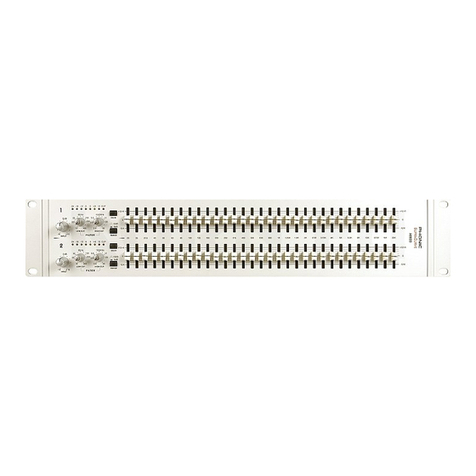
Phonic
Phonic SupraCurve A6600 User manual
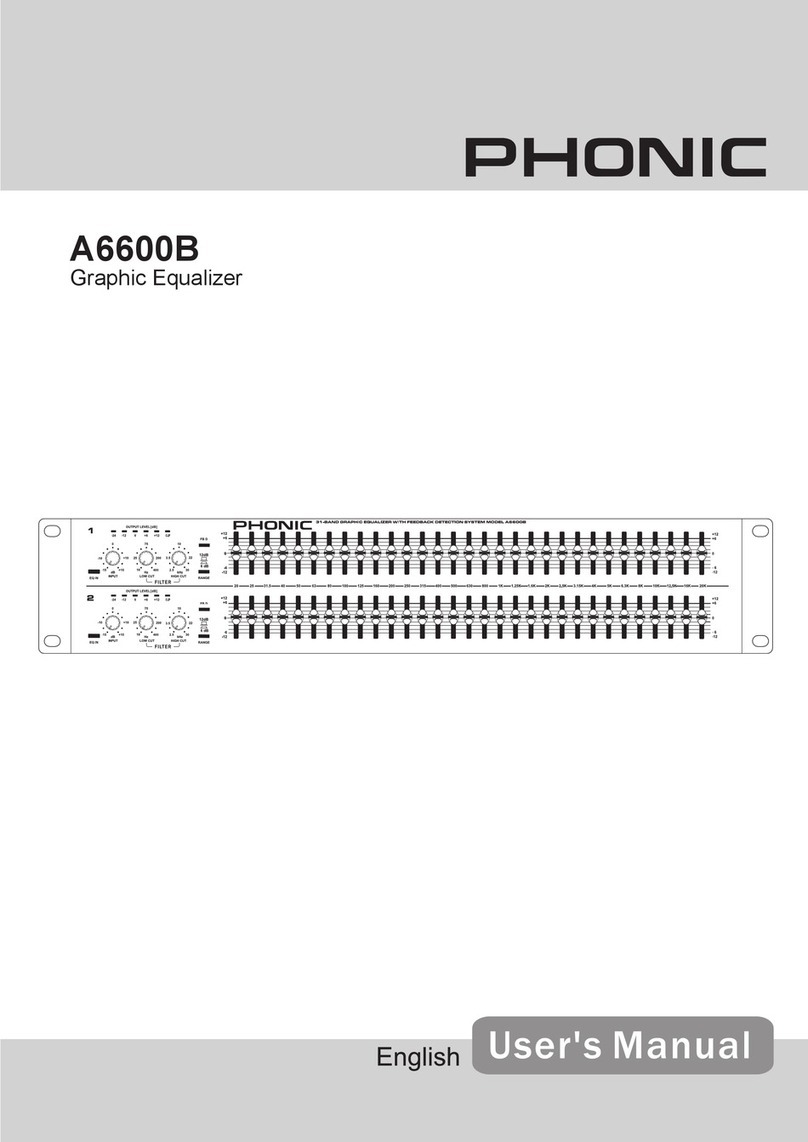
Phonic
Phonic A6600B User manual

Phonic
Phonic MQ3300 User manual

Phonic
Phonic FIREFLY 302 USB User manual

Phonic
Phonic Firefly 808 Universal User manual
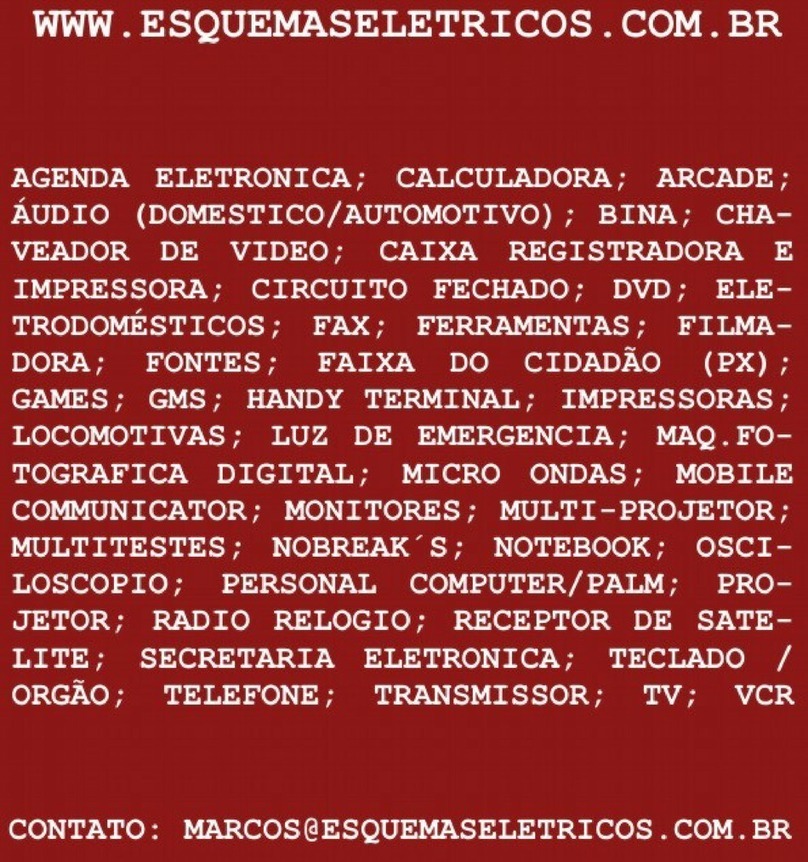
Phonic
Phonic MQ 3229 User manual

Phonic
Phonic DFX 2000 User manual
